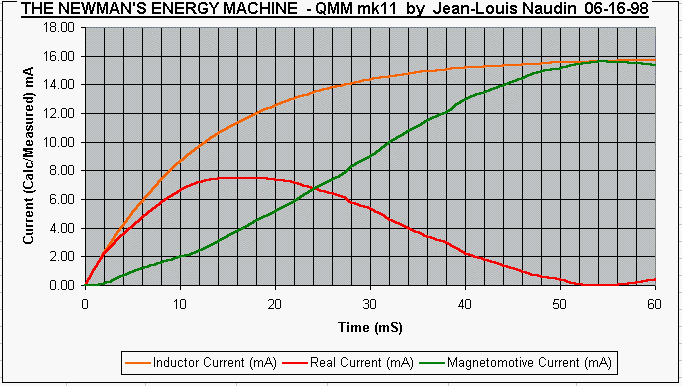
The Newman's Energy Machine
By JL Naudin/M.David
created on 06/12/98 - JLN Labs - last update on 06/20/98
Additional comments :
If you brake the motor with your hands, the pulse
duration will be changed, so the coupling effect between the
"Magnetomotive Energy" ( The REAL magnetic energy
stored in the coil and the additional magnetic energy generated
by the rotation of the magnet ) and the current coming from the
source pulse will be changed too.
Thus the O/U main effect can vanish by this way.
This is the reason why it is NECESSARY to use the "mass
wheel" effect in the rotor to keep the speed constant and by
this way to keep also the energy transfer coupling.
Don't forget that the time constant of the coil (L/R) can't be
changed, so the Newman's machine has its own resonance working
mode. For each change of the rotating speed, the pulse duration
must be adapted for the ZERO CURRENT CUT-OFF PULSE.
Another point, the current curve measured accross the 100 ohms
resistor connected to the coil is the APPARENT CURRENT FLOW which
leaves the coil. This is NOT the REAL current flow INSIDE the
Newman's coil.

You have two kinds of current flow in the coil :
1) the main charging current
(The inductor current in my diagram above) during the rise of the
magnetic energy (when the potential is applied accross the coil).
The value is equal to I=Io (1- Exp (- (R/L) t ) ) with Io=
(Voltage accross the Coil) / (Resistance of the Coil). The
current reaches its maximum at about 5 Tau = 5 x L/R
In my case 5 Tau is about 60 mS. (with the voltage accross the
coil constant)
The magnetic energy in the Coil contributes to generate the
rotation of the magnet in the coil.
2) The other current flow is magnetomotive
current, it is produced by the movement
of the magnet itself in the coil. While the magnetic energy is
stored in the coil, the magnet MOVES in the coil, so the magnet
accelerates and produces a "magnetomotive" current
which contributes to DROP the current measured a the output (the
real current in my diagram above).
The rotating magnet is ACCELERATED during the rise of the
magnetic energy in the coil, this creates the
"magnetomotive" induction in the coil. For an OBSERVER
outside the referential of the coil, the current which comes into
the coil DROPS after a while (the red curve in the diagram above)
and drops to zero.
In the COIL REFERENTIAL there is only one current: this is the
"rise current" I (climbing to Io) and it is maintained
during all the duration of the firing pulse (the orange curve in
the diagram above). This is the reason why the magnet can rotate.
The rotating magnet CAN SEE ONLY ONE CURRENT in its time
referential.
Why ? because a ROTATING TIME FRAME has
not the same time frame referential than a FIXED TIME FRAME (the
Lab's Observer).
I hope that I am able to explain clearly my current thinking
process about the working principle of the Newman's Energy
Machine....
But I agree with all of you, "In theory, there is no difference between theory and practice, but in practice, there is.". So, only a deep and accurate testing (by measuring the mechanical torque output Vs the Electrical Power Input) of this device will prove if my theory exposed above is really true.....
The tests are not yet finished, and all comments are welcome.
Jean-Louis Naudin
Link to the Additional comments (06-19-98)
If you need more informations or if you have any suggestions send me your Feedback
![]() Email
: JNaudin509@aol.com
Email
: JNaudin509@aol.com
Return to the Newman's Machine Main page